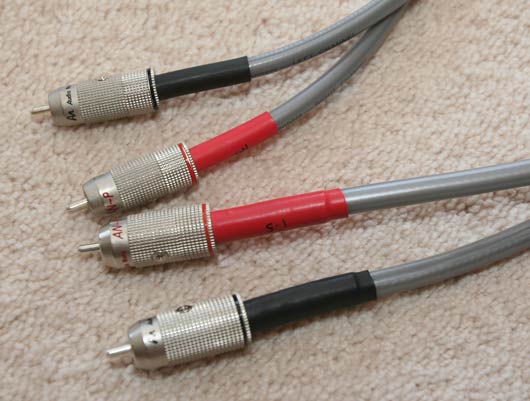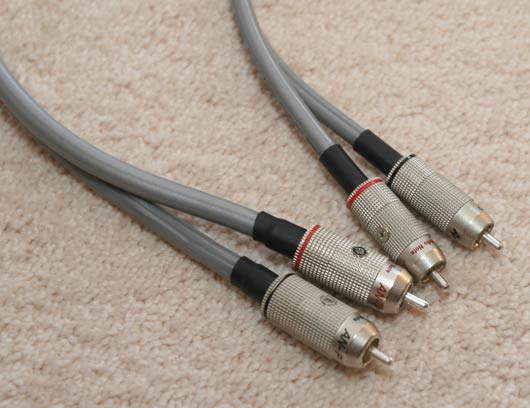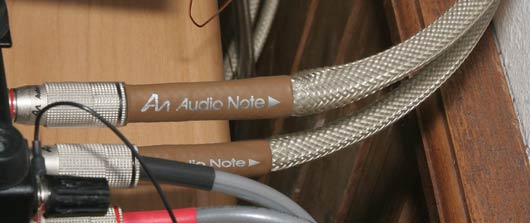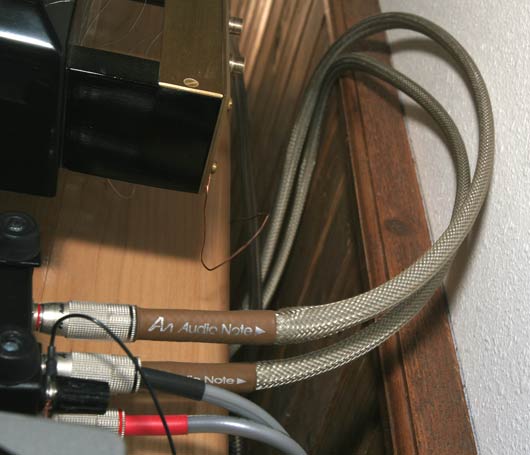Shootout: Audio Note Interconnects: Sogon versus SOOTTO versis PALLAS
A shootout! A shootout!
OK, in this corner weighing in at, well, it is the heaviest cable, is the new top-of-the-line SOOTTO [SO Over The TOp].
In this other corner is the new 50 strand version of the legendary SOGON.
And in this other corner [a lot of corners, yes] is the new limited-quantity low-capacitance minimally shielded PALLAS.

A photo of a 1.5m SOOTTO and 1m SOGON cable. The PALLAS is still on the system (see below).

The SOOTTO is about 50% larger in thickness than this new SOGON50 which appears to be slightly larger than the old SOGON cable.




The PALLAS low capacitance cable on the back of the TT3 Reference turntable. The current configuration is not shielded.

We tested the cables going from the step-up transformer to the Lamm LP2 phono stage and ultimately to the Kharma Mini Exquisites. So this was a test of the low-signal handling capability of the cables on a system that does not have a lot of capacity for detailed bass below 30 Hz or so [but has one of the highest capabilities of midrange resolution of any speaker on the planet].
We think of the AN SOGON cable as analogous to the Nordost Valhalla [which is familiar to many people] – and in general applications, one can be swapped for the other in a reasonably well-designed system with the overall performance remaining about the same.
What this means in practice, is that the upper mids and low treble are more or less the same – and this is the area of most information.
Where they vary, and become useful in customizing a particular system, is that the SOGON has more color in the mid and lower mids, and the Valhalla has more detail in the lows and some of the highs. At least, to a first approximation, this is how we use them.
The second order approximation [i.e. finer differences] come into play when looking at separation and transparency [Valhalla] and continuousness, soundstage consistency, midi-dynamics [SOGON].
The SOOTTO is like a nuclear-powered SOGON.
The [having a hard time thinking about how to describe this very basic attribute], the *power* of the notes are clearly unmatched by any cable we have heard here before. Kind of like a Mohammad Ali punch when he is just playing around – it doesn’t hurt you, but the fists are humongous and you can feel the strength in each note.
Similarly the naturalness of the color of the notes and the smoothness of the transition of the notes one into the other [so that riffs inside melodies were easier to follow] is also exceptional and unmatched [though the Jorma PRIME has a more *vivid* color spectrum].
It was agreed that this was definitely a WOW! and WHOA!!! kind of experience. Reminds me of those Strongman competitions. Other enhancements were the tactility of the notes [not so much the presence, nor solidity, though these were excellent, and related, to tactility but the feeling that one could go up and hug the notes, as opposed to the people or instruments making the notes].
We liked it and it was kind of hard to think about going back to SOGON after doing the shootout [funny, but before a shootout, swapping things here-there-and-everywhere, the differences aren’t so present in one’s mind, but after a shootout where you sit and explicitly listen for differences – you are screwed].
Finally the PALLAS.
First, let’s deal with the unshieldedness. In the position that you see it in in the photo, there is some hum. Not much, and only barely audible from the sweet spot. Compared to the oh so wonderful WBT RCA connectors, which generate hum in that position at about 60-70dB, and make the cables that use them worth less than lamp cord, the hum from the PALLAS is nothing.
The PALLAS is designed by AN for low signal strength connections, and we have not tried it anywhere else.
OK. It is hard to compare the PALLAS to anything we have here. Because of this it will require more listening. But…
It has separation as good or better than the Valhalla – but not as clear sounding – but more clear than the SOOTTO. It sounded more musical than anything we heard in this test. Great transparency, but not like that of, say, the ODIN – things are not outlined with that kind of preciseness – it is more like the center of things is more solid than the edges, but that the roll off of the solidity was exactly what one [me anyway] would expect when one thinks about analog [as opposed to digital].
So, for me, I liked the PALLAS the best and SOOTTO second best in this test. I would hate to live without either – they are so different and I love being able to switch back and forth sometimes. Over time this may change – maybe after we get over the WHOA! experience with the SOOTTO we will come to prefer it. But in general I like the slightly more clean sound of the PALLAS which still retains the harmonics and dynamics of its brethren, if not the impact and POWER.
Again, a reminder, this shootout was for small signal connections. These results are for interconnects between turntable to phono stage, and probably the same results would be achieved between a transport to DAC. Some cables do better than others at this: Stealth INDRA for example does not work nearly as well as Valhalla [and for some reason we have never tried the Jorma Design PRIME. Well, maybe Neli has…]. In fact, we liked and use the plain old Valhalla RCA interconnects almost exclusively in this low-signal capacity. The Odin is better than the Valhalla in low signal connections – and the resultant purity of the overall sound is what dreams are made of – but Odin kicks Valhalla butt all the way to the Moon in high-strength connections, and since our supply of Odin is, so far, uh, limited, you would see Valhalla serving in this capacity here most of the time.
But now we have a few more cables that have proven themselves to be better at the low-signal thang in at least one situation. So next time we move things around, we’ll have More Work to do figuring our which cable sounds best. Oh boy.
I mean, Oh BOY!!! [actually, I do enjoy these shootouts very much, though the turning on and off of equipment over and over is kind of stressful – on the equipment specifically, and making sure we don’t hook up something backwards, or the in to the out, takes some amount of, uh, hmmmmm…. paying attention to the physical world when I just want to focus on the sonic world].
Well, there you have it. There needs to be another shootout, specifically for normal connections, and hopefully in that shootout we will revisit this shootout with any updates, if necessary.

Funny, the first thing you should mention being the bit about feeling the strength in each note from the SOOTTO IC.
That was the very first thing that hit me quite litterally when connecting a SOOTTO MAINS POWER Cable feeding my amp.
I was hearing some acoustic guitar piece and was immediately taken by the way the SOOTTO mains differentiated the different guitar picking. Lending each and every note their own very special “value” of attack and intensity bringing the instrument to life in a heightened very realistic way I hadn’t experienced before. Next were the over all dynamics which I belive are in a gang of one. To be followed by a hitherto unexperienced performance in every other thinkable way.
Very remarkable to me that the same (kind of) cable used for two such quite different purposes as IC and A/C are able to manifest their exact same signature to such an extent.